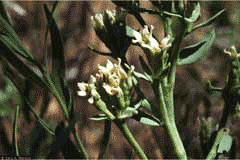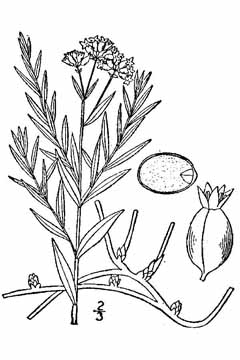 |
|
Gary A. Monroe @ USDA-NRCS PLANTS Database |
 |
| USDA-NRCS PLANTS Database / Britton, N.L., and A. Brown. 1913. An illustrated flora of the northern United States, Canada and the British Possessions. Vol. 1: 640. |
Translate this page:
Summary
Physical Characteristics

 Comandra pallida is a PERENNIAL growing to 0.4 m (1ft 4in). It is in flower from May to June. The species is hermaphrodite (has both male and female organs).
Comandra pallida is a PERENNIAL growing to 0.4 m (1ft 4in). It is in flower from May to June. The species is hermaphrodite (has both male and female organs).
Suitable for: light (sandy), medium (loamy) and heavy (clay) soils and prefers well-drained soil. Suitable pH: mildly acid soils and can grow in very acid soils.
It cannot grow in the shade. It prefers moist soil.
UK Hardiness Map
US Hardiness Map
Synonyms
C. umbellata pallida. (A.DC.)Piehl.
Plant Habitats
Cultivated Beds;
Edible Uses
Edible Parts: Fruit Seed
Edible Uses:
Fruit[105, 161, 177]. A sweet flavour[274]. The fruit is about 10mm in diameter[200]. The small round seeds are eaten like nuts by children[257].
References More on Edible Uses
Medicinal Uses
Plants For A Future can not take any responsibility for any adverse effects from the use of plants. Always seek advice from a professional before using a plant medicinally.
Foot care Narcotic Ophthalmic Salve
The plant is narcotic[257]. A decoction has been used in the treatment of headaches and externally as a foot bath to treat corns[257]. The plant has been used to treat sore eyes and sores on the body and also as a mouth wash for canker sores[257].
References More on Medicinal Uses
The Bookshop: Edible Plant Books
Our Latest books on Perennial Plants For Food Forests and Permaculture Gardens in paperback or digital formats.

Edible Tropical Plants
Food Forest Plants for Hotter Conditions: 250+ Plants For Tropical Food Forests & Permaculture Gardens.
More

Edible Temperate Plants
Plants for Your Food Forest: 500 Plants for Temperate Food Forests & Permaculture Gardens.
More

More Books
PFAF have eight books available in paperback and digital formats. Browse the shop for more information.
Shop Now
Other Uses
Dye
A blue dye is obtained from the area next to the root bark[257].
Special Uses
References More on Other Uses
Cultivation details
Requires a well-drained moisture retentive lime-free soil[200]. A parasitic plant obtaining at least some of its nutrients from the roots of other plants[200, 235]. It is said to parasitize over 200 different species of plants in the wild[274].
References Carbon Farming Information and Carbon Sequestration Information
Temperature Converter
Type a value in the Celsius field to convert the value to Fahrenheit:
Fahrenheit:
The PFAF Bookshop
Plants For A Future have a number of books available in paperback and digital form. Book titles include Edible Plants, Edible Perennials, Edible Trees,Edible Shrubs, Woodland Gardening, and Temperate Food Forest Plants. Our new book is Food Forest Plants For Hotter Conditions (Tropical and Sub-Tropical).
Shop Now
Plant Propagation
Seed - stratify for 3 months at 5°c and then sow in the greenhouse in a pot with a suitable host. Plant out when it is well established close to a mature host plant[200].
Other Names
If available other names are mentioned here
Native Range
NORTHERN AMERICA: Canada (Manitoba, British Columbia), United States (Minnesota, Colorado, Montana, Oregon, Washington, Wyoming, New Mexico, Texas, Arizona, Nevada)
Weed Potential
Right plant wrong place. We are currently updating this section.
Please note that a plant may be invasive in one area but may not in your area so it's worth checking.
Conservation Status
IUCN Red List of Threatened Plants Status :

Growth: S = slow M = medium F = fast. Soil: L = light (sandy) M = medium H = heavy (clay). pH: A = acid N = neutral B = basic (alkaline). Shade: F = full shade S = semi-shade N = no shade. Moisture: D = dry M = Moist We = wet Wa = water.
Now available:
Food Forest Plants for Mediterranean Conditions
350+ Perennial Plants For Mediterranean and Drier Food Forests and Permaculture Gardens.
[Paperback and eBook]
This is the third in Plants For A Future's series of plant guides for food forests tailored to
specific climate zones. Following volumes on temperate and tropical ecosystems, this book focuses
on species suited to Mediterranean conditions—regions with hot, dry summers and cool, wet winters,
often facing the added challenge of climate change.
Read More
Expert comment
Author
A.DC.
Botanical References
43200274
Links / References
For a list of references used on this page please go here
Readers comment
| Add a comment |
|
If you have important information about this plant that may help other users please add a comment or link below. Only comments or links that are felt to be directly relevant to a plant will be included. If you think a comment/link or information contained on this page is inaccurate or misleading we would welcome your feedback at [email protected]. If you have questions about a plant please use the Forum on this website as we do not have the resources to answer questions ourselves.
* Please note: the comments by website users are not necessarily those held by PFAF and may give misleading or inaccurate information.
To leave a comment please Register or login here All comments need to be approved so will not appear immediately.
|
Subject : Comandra pallida
|
|
|
|